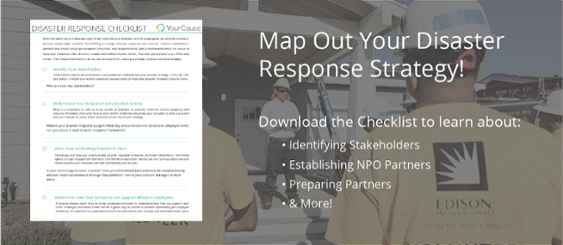Although we never want to see disaster happen, every company needs to plan for it. The unexpected news of a disaster occurring can disrupt the communities that businesses serve and where their employees and customers work and live in. All over the world, we see natural catastrophes come unpredictably, from flooding and hurricanes to ice storms and wildfires. In 2019 alone, there were 820 events world-wide that occurred and disrupted communities, causing losses of over $52 billion. When it comes to proactive planning, companies go above and beyond to ensure resources will be available to keep their employees safe, protect their facilities, and perform recoveries during a disaster response. Within the organization, Business Continuity works diligently to ensure that all business units are aligned, leadership has signed off on the processes, and the right support is allocated should these events occur.
Corporate social responsibility touches on all areas of business when a disaster response plan is in motion. Should disaster strike, communities and employees expect support, non-profit organizations and charities need funding, and people ultimately want to know how they can help.
So how can your CSR effectively plan for disaster relief?
Find a partner to serve with purpose.
When planning for the future of your CSR programs, carving out a disaster relief response plan is one of the key areas that should be part of your strategy. As a corporation, there is an opportunity to double up on response efforts, volunteering, donations, and outreach – especially if you’ve taken the time to team up with the nonprofit sector already. Building a relationship and outlining a relief plan with other organizations can help companies respond faster and see impact at a greater level. For example, Red Cross Canada offers training programs for volunteers with specific skills to help during a time of need.
Aligning these needs with your internal skills-based volunteer program can help if there is a need for volunteers at any given time to respond to disasters. This also helps further engage your employees when they ask the question how can I help?. If a disaster response team is created during the planning stages, and employees are readily trained and understand their role and responsibilities, they’re more likely to volunteer their time and efforts because they’ll feel prepared and ready to help.
Engage your local charities and become familiar with their reach.
Providing large donation amounts to the nonprofit sector is a straightforward and effective response when funds are quickly needed to help with relief efforts. A major plus-side to engaging in this disaster response is companies who participate in these initiatives do not go unnoticed. When disaster strikes and help is needed, CSR is looked at to act quickly, whether it’s donations to charities, supporting their employees, or ensuring their stakeholders know they are providing support. Engaging local charities is a way to support communities one step further, and sometimes a little act goes a long way. Encouraging donations and support through smaller nonprofit organizations helps both internally and externally:
- Employees and customers will recognize that their communities are being served. Through volunteer opportunities and various charities listed as an option to donate to, companies can remain a voice for the under-served communities who need extra support.
- There is more successful outreach. Local charities know their communities – inside and out. They understand, firsthand, what will help families in need, whether it’s funding, in-kind donations, support through volunteering – they are the experts.
This type of knowledge is important when building relationships with your local communities and companies can benefit from this as well. Throughout the year, it’s beneficial for a CSR team to research and understand the unique efforts in all the communities they serve. When an event occurs, these relationships will quickly turn into opportunities for giving, volunteering, and outreach.
Activate your campaigns.
In preparation to act promptly, one area to think about is setting aside budget and resources to match donations and provide employee nominated grants during a time of need. This is complementary to your rolling annual campaigns such as giving month or nominated grants – since most of these events are unexpected and difficult to plan for in terms of timing.
By activating a match campaign, your employees will trust their impact will be doubled if they donate through their company. Aligning match donations with established local charities also helps with telling a more collaborative story. Enabling employees to nominate charities for funding helps engage your people while building trust with both your employees and your communities.
There are several ways to get creative and prepare for disaster relief response. The key is to plan, brainstorm, and to take the time to research and understand trends. The more strategizing done ahead of time can help alleviate reactive responses when help is needed. Creating a disaster relief response plan and considering it a CSR program unique to your company is helpful for your brand, reputation, and employee and community engagement. Support will never go unnoticed and small acts of giving will help your company in the future.
from npENGAGE https://ift.tt/2JOlhdq

0 comments:
Post a Comment